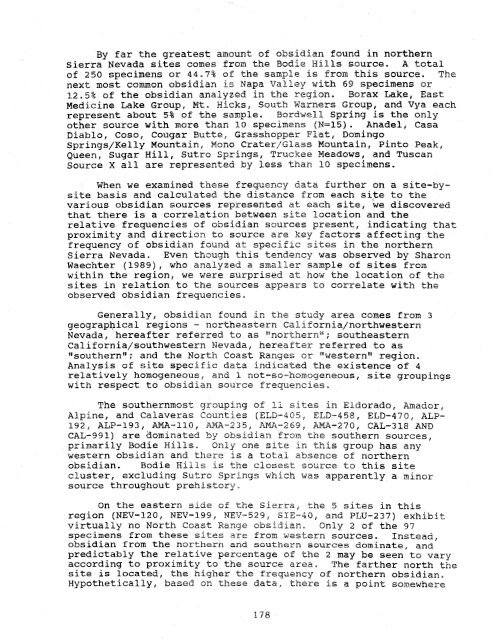regional prehistory and california-great basin - Society for California ...
regional prehistory and california-great basin - Society for California ...
regional prehistory and california-great basin - Society for California ...
You also want an ePaper? Increase the reach of your titles
YUMPU automatically turns print PDFs into web optimized ePapers that Google loves.
By far the <strong>great</strong>est amount of obsidian found in northern<br />
Sierra Nevada sites comes from the Bodie Hills source. A total<br />
of 250 specimens or 44.7% of the sample is from this source. The<br />
next most common obsidian is Napa Val with 69 specimens or<br />
12.5% of the obsidian analyzed in the region. Borax Lake, East<br />
Medicine Lake Group, Mt. Hicks, South Warners Group, <strong>and</strong> Vya each<br />
represent about 5% of the sample. Bordwell Spring is the only<br />
other source with more than 10 specimens (N=15). Anadel, Casa<br />
Diablo, coso, Cougar Butte, Grasshopper Flat, Domingo<br />
Springs/Kelly Mountain, Mono Crater/Glass Mountain, Pinto Peak,<br />
Queen, Sugar Hill, sutro Springs, Truckee Meadows, <strong>and</strong> Tuscan<br />
Source X all are represented by less than 10 specimens.<br />
When we examined these fre~uency further on a site-bysite<br />
basis <strong>and</strong> calculated the distance from each site to the<br />
various obsidian sources represented at each site, we discovered<br />
that there is a correlation between site location <strong>and</strong> the<br />
relative frequencies of obsidian sources present, indicating that<br />
proximity <strong>and</strong> direction to source are key factors affecting the<br />
frequency of obsidian found at speci sites in the northern<br />
Sierra Nevada. Even though this tendency was observed by Sharon<br />
Waechter (1989), who analyzed a smaller sample of sites from<br />
within the region, we were surprised the location of the<br />
sites in relation to the sources appears to correlate with the<br />
observed obsidian frequencies.<br />
Generally, obsidian found in the area comes from 3<br />
geograp~ical regions - northeastern Cali<strong>for</strong>nia/northwestern<br />
Nevada, hereafter referred to as "northern"; southeastern<br />
Cali<strong>for</strong>nia/southwestern Nevada, hereafter referred to as<br />
"southern"; <strong>and</strong> the North Coast Ranges or "western" region.<br />
Analysis of site specific data indicated the existence of 4<br />
relatively homogeneous, <strong>and</strong> 1 not-so-homogeneous, site groupings<br />
with respect to obsidian source frequencies.<br />
The southernmost grouping of ll s in Eldorado, Amador,<br />
Alpine, <strong>and</strong> Calaveras Counties {ELD-405, ELD-458, ELD-470, ALP-<br />
192, ALP-193, AMA-110, M1A-235, k~-269, AMA-270, CAL-318 AND<br />
CAL~991) are dominated by obsidian the southern sources,<br />
primarily Bodie Hills. Only one site this group has any<br />
western obsidian <strong>and</strong> there is a total absence of northern<br />
obsidian. Bodie Hills is the closest source to this site<br />
cluster, excluding Sutro Springs was apparently a minor<br />
source throughout <strong>prehistory</strong>.<br />
on the eastern side of the Sierra 1 the 5 sites in this<br />
region (NEV-120, NEV-199, NEV-529, SIE-40, <strong>and</strong> PLU-237) exhibit<br />
virtually no North Coast Range obs . Only 2 of the 97<br />
specimens from these sites are from western sources. Instead,<br />
obsidian from the northern <strong>and</strong> southern sources dominate, <strong>and</strong><br />
predictably the relative percentage the 2 may be seen to vary<br />
according to proximity to the source area. The farther north the<br />
site is located, the higher the frequency of northern obsidian.<br />
Hypothetically, based on these data, there is a point somewhere<br />
178
















